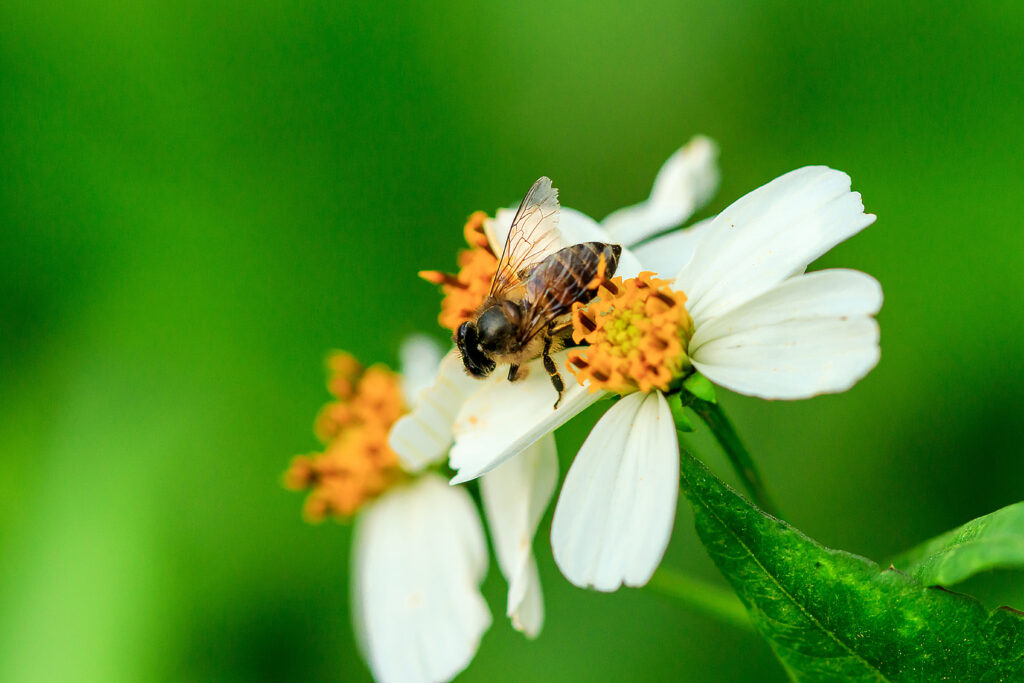Appreciate your Fall Wildflowers

Bee on the pollen Spanish needle

Bee on the pollen Spanish needle [Submitted]
New Floridians, accustomed to the beautiful and dramatic seasonal changes back home might bemoan the lack of change down here. Truth is, evidence of fall can already be detected among the roadside plants. Jump in the car, and let’s see what the natives see.
Take a casual ride in the country. If you’re fortunate enough to live in a natural area, simply take a walk to find most of these treasures.
One of my favorites is the ordinary broomsedge, or Andropogon virginicus. At this time of year this two-foot-high grass appears randomly in small clumps along the roadside, especially in sandy or infertile areas. Its tall seed stalks are sleek and green with occasional leaves tipping gracefully down. After the frost it turns golden brown and is useful as a filler in fall arrangements. Broomsedge can also be harvested for dyes and medicinal uses. When I was in elementary school (our school was bordered by wild areas and fence lines) the boys would shoot the spear-like seeds at the girls and send them running.
Showy crotalaria, Crotalaria spectabilis, is another favorite of mine, with its bright yellow flowers standing like snapdragons up to three feet tall. As kids we loved to squeeze the green seed pods, or “poppers.” When shaken, the dried pods made a nice noise too, hence the other name rattlebox.
I hope you scope out some patches of Crotalaria this fall, but whether green or dried, cCotalaria and especially its seeds are toxic to all livestock. Because of this, when I was little, my sister, in hopes of getting a horse, took it upon herself to rid our back field of any trace of this weed. She eventually got her horse, but that’s another story.
Another roadside bloomer is lantana. Found just about everywhere along the road, lantana, or Lantana strigocamara can reach up to six feet tall and is covered with one-inch clusters of mixed gold, pink, and red blooms, This minty-scented plant and its berries, which resemble blackberries, are toxic. It is also an invasive, so avoid digging it up to take home.
However, if you find it irresistible you can purchase the endangered Lantana depressa at your native plant store instead. By adopting and cultivating the native you’ll help rebuild its numbers.
Lantana strigocamara is still food for many wild critters, especially bees and butterflies, and I for one, will continue to admire its beauty.
Yellow goldenrod, or Solidago, is also prevalent this season. Who hasn’t heard of Thomas Edison’s search for a native source of latex using goldenrod? These tall shaggy heads of tiny golden flowers grow to 3 feet high. The pointy-topped blooms are a rich haven for bees and other pollinators. Since the pollen is sticky and heavy and does not blow far from the plant, goldenrod is no longer deemed the serious allergen problem it once was. In fact, goldenrod has many health and medicinal benefits. I’ll include a link for further research.
Have you noticed the horsemint, or Monarda puntata clustered at the base of fenceposts? Known also as bee-balm or wild mint, its showy bracts grow in clusters of pale pink, purple, or cream, and will remain colorful long after winter kills the surrounding greenery. Tiny, hard-to-see blooms nestle within the bracts. It is related to thyme, basil, rosemary, and oregano, and Native Americans used it to treat colds, skin problems, fevers, and headaches.
Spanish needle, or Bidens alba with its yellow center and white petals is by far one of the most common flowers along the roadways. Left alone it reaches six feet in height. Its sprawling form is unattractive, its needle-like seeds cling to socks and pants, and most consider it a pest. But look again. The flowers are covered with pollinators like butterflies and bees. And did you know this plant is edible and medicinal? I’ll include a link so you can explore more.
I’ve saved my very favorite, the native beautyberry or Callicarpa americana for last with its long arching branches and purple berry clusters arranged like shish kabobs among the leaves. Look for this plant near trees and woods. It is harder to spot than the flowers above, but its beauty is on display now. Once you see this spectacle you will not forget it.
I grew up all my life thinking beautyberries were toxic. Not so. In fact, I’ll include a link for making the most delicious jelly you can imagine. I tried it out this week from the plant in my back yard. And I’m still alive. However, as with any wild plant, do your own research. Make sure you have the right bush. One can be sensitive or allergic to the berries or leaves.
Another benefit of the beautyberry plant is its leaves can crushed and rubbed on the skin to repel mosquitoes. I pureed some with water and made a green juice. It worked handily but can stain. Again, be cautious regarding potential allergies.
What a rich abundance. Now, along with our natives, new Floridians can catch that first hint of fall and recognize the beauty and resources that surround us. Just think, by identifying these few plants you will have learned at least seven new things today.
Enjoy your explorations.
Spanish Needles / Shepherd’s Needles (wildsouthflorida.com)
https://hearthandvine.com/beautyberry-jelly/
Jennifer Odom is an avid gardener and an Ocala-based author. Her latest novel “Girl with a Black Soul” was recently released. For information visit jenniferodom.com





